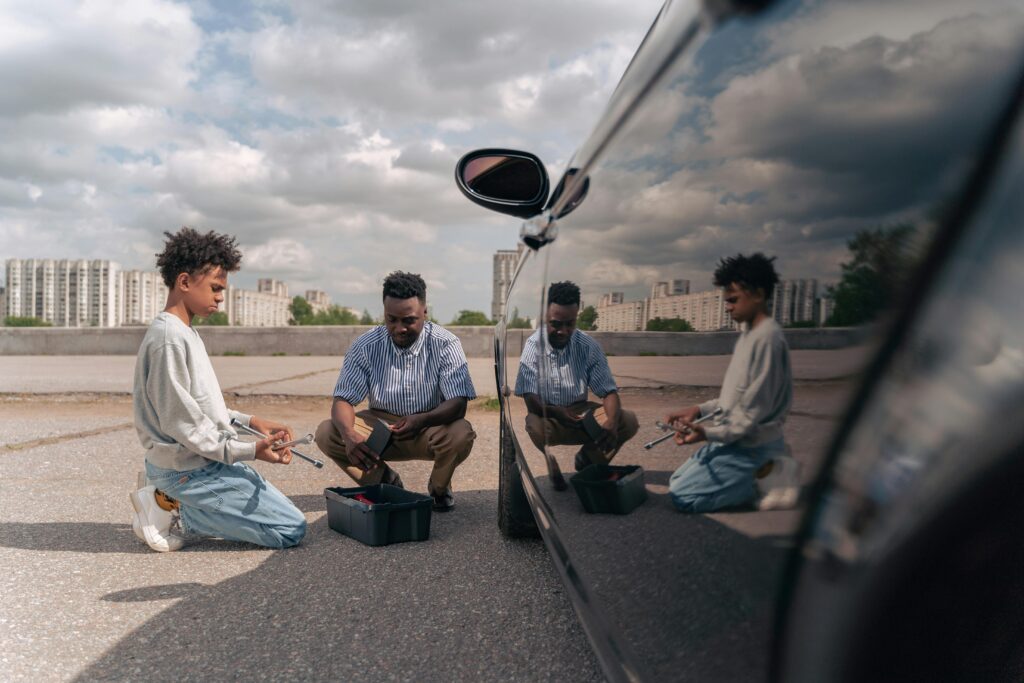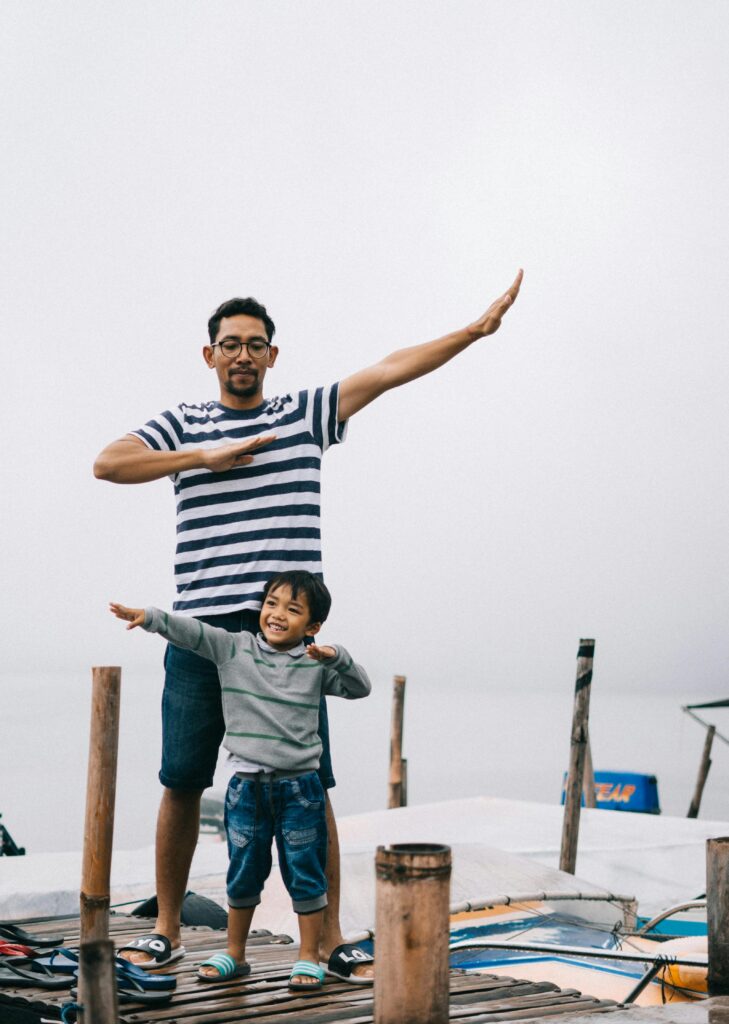
What can a child teach you? It’s something we don’t always think about because we’re so busy with everyday life. Us adults sometimes forget that kids have great insights too. What if we saw kids as experts in certain aspects of life? We’d realize that we have incredible role models right in our own homes! In this article, we will discover 7 things we can learn from kids.
Let’s dive right in!
Embrace Curiosity and Ask Questions
Kids are natural learners—they constantly absorb everything around them, whether they’re playing, talking, or exploring. As we get older, that ability to soak up new information fades.
Think about it: the curiosity of a 70-year-old rarely matches that of a 6-year-old (exceptions aside). Children want to understand how things work; they’re actively trying to make sense of the world.
The other day my son came to me with a burning question: “Mama, how come the sink drain never fills up, even when we pour in sooo much water?” That led us into a little talk about how water doesn’t go straight to the sea.
Kids have a natural drive to understand, and we as adults can learn so much from that! Imagine if we kept up that curiosity—it would keep our minds open and growing.
I know I’d probably be more like Mat, who seems to know something about everything—from biology to politics to sports.
The men in my house remind me just how much we can learn from staying curious!
Maybe you have someone like that in your life too?
Judgment and the fear of it
Kids ask questions freely, without worrying that they will be judged for it. They assume others have good intentions, and they know they don’t know everything—which is why they ask!
How amazing would it be if we, as adults, believed the people we talk with are eager to share what they know with us. And could we be humble enough to admit we have plenty to learn?
Too often, we listen with judgments ready, thinking we already know what the other person is going to say. We stop being curious, and we miss out on truly understanding.
In the Bible, Jesus tells us to become like children to enter the kingdom of heaven. He saw humility, honesty, and purity in the child in his arms — no pretense or hypocrisy, just simple faith.
Could we learn from kids in this area?
What if we asked more questions? What if we placed new knowledge into our minds rather than fitting it into pre-existing “boxes”? This kind of curiosity could help us grow both personally and professionally.
Our relationships would improve, too, as we show genuine interest in others’ passions, giving them the joy of sharing.
Think of someone in your family you could show some curiosity towards. Maybe they’re good at something practical, know how to dance, or have been married for years. There’s always something we can learn from others.
Let’s grow and improve our relationships while we’re at it!
The Lesson: Never stop asking questions or seeking to learn more about the world around you.
Be Honest About Your Boundaries
Kids are refreshingly open about their boundaries. They say what they feel, even if it can lead to those awkward moments—like when they refuse to answer or don’t want to give a hug.
Any parent has probably been on the receiving end of that!
On one hand, I’m teaching my kids to be polite and respond to adults. But you know what? On the other hand, I admire how my kids naturally hold their boundaries!
What we can learn from kids here
As adults, we often know what’s “expected” in social settings, which helps us fit in. Yet, there are times when it would serve us better to be honest about our boundaries, just as kids are.
Sometimes, raw honesty is exactly what a situation or relationship needs. 😊
When we communicate our boundaries with kindness and respect, our relationships can actually grow stronger. Being honest about what we’re comfortable with, allows others to understand and respect that we’re looking out for ourselves.
The Lesson: Be honest about your boundaries and authentic in your communication—this builds trust and deeper connections
(Just remember to show a little more tact than a child would😉)

Be Authentic in Your Emotions
My son’s face is priceless when I take a moment to REALLY compliment him on something he did well. The other day, I pulled him onto my lap, gave him a kiss, and told him I was so proud of him for being kind to someone.
His expression was beyond words—he soaked it all in, and a disarming, joyful, enduring smile joined his blushing cheeks. It’s so heartwarming to see how easily kids express their emotions!
They are so much better at letting their guard down than most adults, myself included.
I know that while I’m often expressive (or so people say!), I still wouldn’t feel entirely free to scream out of joy. Instead, I express my emotions loudly when I’m alone in the car 😊 —singing and praising God at the top of my lungs!
Kids, on the other hand, wouldn’t wait until they’re alone; they embrace their freedom to be fully themselves.
In the Bible, when children shouted praises of “Hosanna to the Son of David!” the chief priests and teachers tried to silence them. But Jesus welcomed their joyful praise, showing that the adults were the ones who needed to adjust their perspective.
Children praise God with songs and dance automatically.
They express their feelings without holding back or overthinking; they’re entirely transparent and honest in that way.
How can we learn from kids in this?
Of course, it’s important for everyone to learn emotional regulation—there’s a time and place for everything. A fit of rage in the supermarket is not exactly desirable. And we usually try not to break down in tears during a meeting.
But honestly, when is the right time? Do we, as adults, make space to express our feelings? Or do we just keep pushing them down?
We need to take care of ourselves. Part of that is making sure that we are healthy emotionally. Adults have so much to learn from kids in this area!
How freeing is it to just let go of your tears after you lost your father, even if it was years ago? Or what if you are so happy that you want to scream it out? Would you do it?
God created us with emotions; they’re a part of who we are. So why shouldn’t we make space for them?
Let’s not always be tempered, let’s also not totally overwhelm others, but let’s be real.
It will reduce stress and can improve our communication with friends and family, if done the right way.
The Lesson: Don’t bottle up emotions—express them authentically and healthily.
Find Joy in The Little Things
He was racing through the house, waving his hands in the air like he was about to take flight. Since he moved faster than the speed of light, it was hard to see at first who it was. “Come and see!” he called, urging me to witness something incredible. Ah, it was my son. When I joined him, he proudly showed me our front gate on Google Earth, utterly amazed that “it knew our house.” The look of pure joy and amazement on his face is something I’ll never forget.
What can we learn from this?
We can learn to find joy in the simplest things. Kids get excited so easily!
It is contagious how they appreciate a new toy, playing in a puddle, a hug from a parent or a theater show.
But for us adults, it can feel harder to reach that place of genuine wonder. We often feel like we’ve seen it all before—but have we really?
Let’s not overlook life’s small pleasures. The wonderful things God has created are all around us—the way a little girl tenderly cares for her dolls or the way teenagers embody both children and adults at once.
Sure, the busyness and stress of life make it hard to pause sometimes.
But if we set aside even a moment to appreciate what’s around us, we’ll find ourselves becoming happier, more grateful people.
We will start to see the world around us through different eyes. Through children’s eyes, if you will 😉
The Lesson: Take time to appreciate the simple moments and embrace joy in everyday life.

Be Fearless and Take Risks
“I’ve never done it before, so I think that I can do it!”
Do you remember Pipi Longstocking? The over-confident red-haired girl in her 80s TV show?
Pipi Longstocking is a child that we can take as an example. Over-confident as she is, she is not an exception to how most kids approach the world.
This extra-bold, courageous, and curious outlook is often why children can accomplish things that might take adults much longer.
When kids see a mountain, they want to climb it.
They approach new things without hesitation, whether it’s a new friend, a new activity, or learning to ride a bike.
Until they hit puberty, kids are often not weighed down by insecurity, limits, or fear of others’ opinions—they simply have faith.
My son shows this courage too. When he meets someone new, he’ll ask them right away if they want to be his friend. They either say yes or no, and he moves forward,unafraid to put his heart on the line. He has enough confidence for it!
It’s a practical, effective way to make friends quickly 😋.
I realize I could learn a lot from him in this area—I’m not nearly as comfortable being that vulnerable! Are you?
Why is it that as adults, we rarely ask if someone wants to be friends, even when we’d love to know?
And professionally, we often hesitate, fearing rejection, instead of confidently asking if someone wants to partner with us or buy from us.
How can we learn from kids in this?
Perhaps it’s time to look at our challenges through Pippi’s “glasses”—no more fear of failure or judgment, just pure belief in what’s possible. Cause often, it is.
Imagine the possibilities if we, as adults, adopted Pipi’s mindset!
We could achieve so much more if we dared to take a leap and reach out.
The Lesson: Don’t let fear of failure hold you back—climb that mountain!
Get Your Creative Juices Flowing!
Kids have the most vivid sense of imagination. They are not held back by limitations, as we said. Because of this, kids are much more creative.
They dream of utopian ideas, like no more hunger or world peace. They dream of perfection and genuinely believe these things are possible to obtain.
Us adults can take children as an example by letting go of limiting thoughts during the brainstorming phase.
To make anything happen, you have to believe in it first.
How often do we dismiss ideas because they seem unrealistic or too challenging? But this kind of thinking keeps us in a loop. It’s very hard to come up with transformative ideas like that!
Can we learn from kids in this?
Think about the iPhone. It was imagined before the technology existed to create it. Its designers weren’t held back by limitations.
Next time we run into problems that seem impossible to solve, let’s think of how a child might view it—or better yet, ask them!
It could not only provide a fresh perspective, but it would also show your child that you value their creativity. And you should 😉.
Learning from kids requires trust. If we as parents are too afraid to lose control, we miss the chance to learn from our children’s unfiltered ideas.
Constantly telling them what they can’t do or what isn’t possible, will eventually rob them of their creativity and initiative.
Let’s give our kids the space to practice their creative muscles!
Ask for their input when setting up rules in and around the house. Brainstorm together with them on world problems..
By showing our child respect in this way, we strengthen our relationship with them and rediscover our own creativity along the way!
The Lesson: Don’t disregard ideas by thinking in limitations – Ask your creative child for advice

Find Flow Through Play
As adults, we can be so busy being “grown up” that we rarely take time to play.
We’re always working or taking care of tasks because they need doing, and when we finally pause (if we ever truly do), we’re often too exhausted to do anything but rest. Sounds familiar?
Kids, however, know that play is important.
They are so professional at it, that they are fully present in the moment.
They forget everything around them—whether it’s a parent asking them to tidy up or even a full bladder 😂.
No, but seriously, without playing: Kids know how to get themselves into a flow.
Young kids and teenagers can take the simplest items—a peg, a plastic bag—and turn them into sources of endless entertainment.
They find creative ways to explore, experiment, and see what happens if you add water or fire to the occasion.
Take my daughter, for instance. She takes colored pencils and finds a trillion ways to play with them. She organizes them, puts them in something, takes them out, puts them in something else, and drives them around the house in her play stroller. She enjoys herself and learns while she’s at it.
How kids get into a flow state? They are not busy with future worries or distracted by technology.
The thing we can learn from kids here
What was the last time you were in a flow state?
Play reduces stress, boosts creativity, enhances problem-solving, strengthens relationships, and promotes happiness. That’s impressive!
So, if you find yourself tired even after resting, maybe it’s time to play.
If you’re unsure where to start, ask your child if you can join their play. They know how to do it. Sit beside them, watch and learn.
I am sure you will have a wonderful conversation that will bring a smile to your face.
The Lesson: Play to reduce stress, fuel creativity to solve problems and strengthen your relationships.
Conclusion
As we’ve seen, there is so much we can learn from kids. If we could master even a few of the lessons they teach us, we’d surely enjoy life more deeply!
Let’s take these insights to heart and discuss them with family and friends to see their perspectives. Why not invite the kids into the conversation too? 😉
Think we missed something? Let us know in the comments!
Thanks for reading!
Magnuson, C. D., & Barnett, L. A. (2013). The playful advantage: How playfulness enhances coping with stress. Leisure Sciences, 35(2), 129-144. https://doi.org/10.1080/01490400.2013.761905
Aune, K. S., & Wong, N. C. (2002). Antecedents and consequences of adult play in romantic relationships. Personal Relationships, 9(3), 279-286. https://doi.org/10.1111/1475-6811.00019
